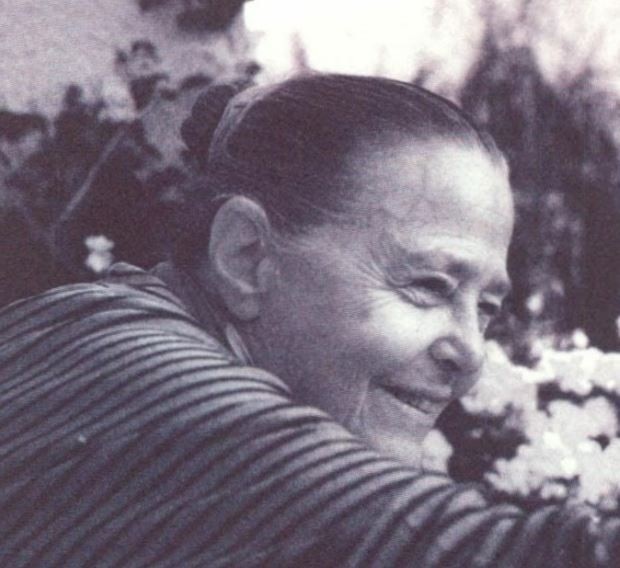Empirical, inspiration-driven work, studying nature and craft techniques – “Instead of examining machines the way they did at the Bauhaus” – from which legendary pieces such as the tilting chaise longue and the Grand Comfort armchair, the Nuages bookcases or the furniture for the Unité d'Habitation in Marseille, and the interiors for ski resorts in the Alps were born: Charlotte Perriand, a central figure for modern design, built from the very beginning a career that is a manifesto of principles and action for design practice. Hers is the name that is now no longer “behind” but “on” the furniture associated with Le Corbusier's architecture, and – unlike Eileen Gray, a figure too long left in the shadows of history – she has always been a reference for furniture design, even at the cost of contemporary and posthumous critical battles in a landscape dominated by male figures. In September 1988, on issue 657, Perriand told Domus about the origin of her vision and her most famous designs.
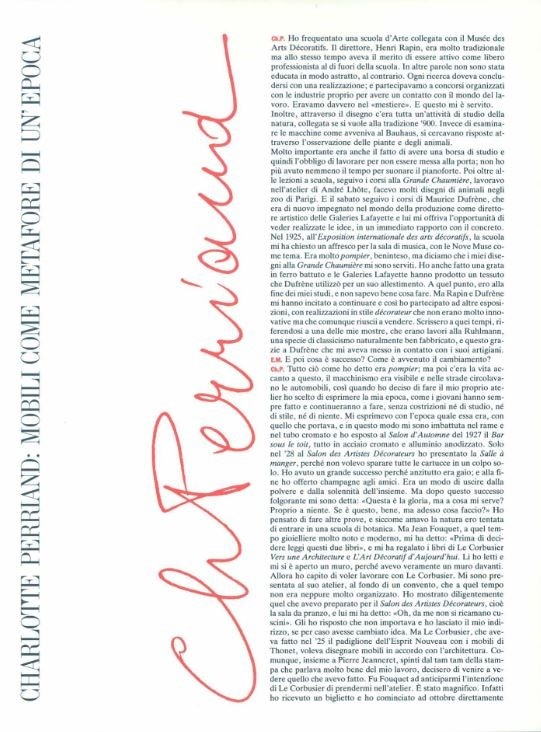
Charlotte Perriand: Furniture as a Metaphor for an Era
I attended an art school connected with the Musée des Arts Décoratifs. The headmaster, Henri Rapin, was very traditional, but he should also be given credit for doing professional work outside the school. In other words, I didn’t receive an abstract education. Quite the contrary. All our research work had to lead to something concrete, something which was actually done. And we participated in competitions organized by firms in order to have contacts with the world of production. We really were part of the «trade». And this helped me. Furthermore, through our design work we also studied nature; this was probably linked to the tradition at the beginning of the century. Instead of examining machines the way they did at the Bauhaus, we sought answers by observing plants and animals.
Another important fact was that I had a scholarship, so I had to work hard to keep from getting kicked out. I didn’t even have time to play the piano anymore. In addition to my lessons at school, I also attended courses at the Grande Chaumière, I worked in André Lhóte’s atelier and I made lots of drawings of animals at the Paris zoo. And on Saturday I went to Maurice Dufrène’s course. He had returned to the world of production and he was the art director of the Galeries Lafayette. He gave me a chance to realize my ideas, in an immediate relationship with the real world.
In 1925, for the Exposition Internationale des arts décoratifs, my school asked me to do a fresco for the music room, with the Nine Muses for a theme. It was very pompier, of course, but I think the drawings I did at the Grande Chaumière helped me. I also did a wrought-iron grating and the Galeries Lafayette made a fabric which Dufrène used for his installation. At that time I had almost finished my studies and I wasn’t sure what I wanted to do. But Rapin and Dufrène insisted that I continue, so I took part in other expositions. The things I did were in the décorateur style and they weren’t very innovative, but I succeeded in selling some. At that time the critics compared my work with Ruhlmann’s, a sort of Classicism. Naturally, my work was well done, thanks to Dufrène who put me in touch with his craftsmen.
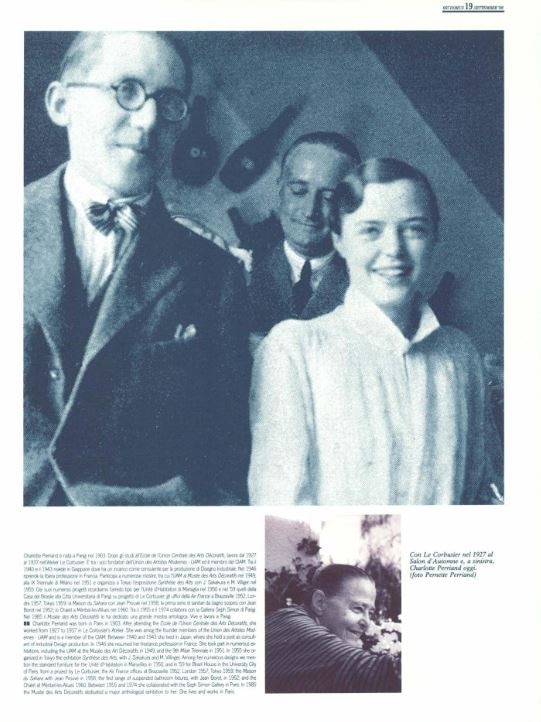
Enrico Morteo: Then what happened? How did the change come about?
Like I said, all this stuff was very pompier. But we were surrounded by life; mechanization was visible and there were cars in the streets. So when I decided to set up my own atelier I decided to express my own times, the way the young always have done and will continue to do, without any constrictions of study, style or what have you. I expressed myself with the age the way it was, with what it brought with it. In this way I came across copper and chrome-plated tubing.
I exhibited at the Salon d’Automne my Bar sous le toit; everything was chrome-plated steel and anodized aluminum. I didn’t present the Salle à manger until the 1928 Salon des Artistes Décorateurs because I didn’t want to be left without any ammunition. It was a big success because it was cheerful, above all. Afterwards, I treated my friends to champagne. It was a way to get out from a dusty and formal atmosphere.
But after this astounding success I said to myself: “This is glory, but do I need it? Absolutely not. If that’s what it is, OK, but what am I going to do now?”. I thought of trying other things; since I loved nature I was tempted to go to a botanical school. But Jean Fouquet, a very famous and modern jeweller at the time, said to me: “Read these two books before you decide”, and he gave me Vers une Architecture and L’Art Décoratif d’Aujourd’hui by Le Corbusier. I read them and the wall that had been in front of me crumbled at my feet. Then I realized I wanted to work with Le Corbusier. I went to his workshop at the rear of a convent; at that time it wasn’t even well organized.
I diligently showed him the things I had prepared for the Salon des Artistes Décorateurs - the dining room. This is what he said: “Oh, I don’t need any cushions here”. I answered that it didn’t matter and I left my address in case he changed his mind.
But Le Corbusier had used Thonet furniture in 1925 for the Esprit Nouveau pavilion and he wanted to design his own furniture in harmony with the architecture. At any rate, driven by the good things the press had to say about my work, he and Pierre Jeanneret decided to come and see what I had done. Fouquet was the one that told me that Le Corbusier intended to take me on in his atelier. It was wonderful. In fact, I received a note and I started in October as a collaborator, not as an apprentice. They put me to work on the program for storage units, tables and chairs: home furnishings, in other words. It was the follow-up to my 1925 studies and it led us to the 1929 Salon d’Automne.
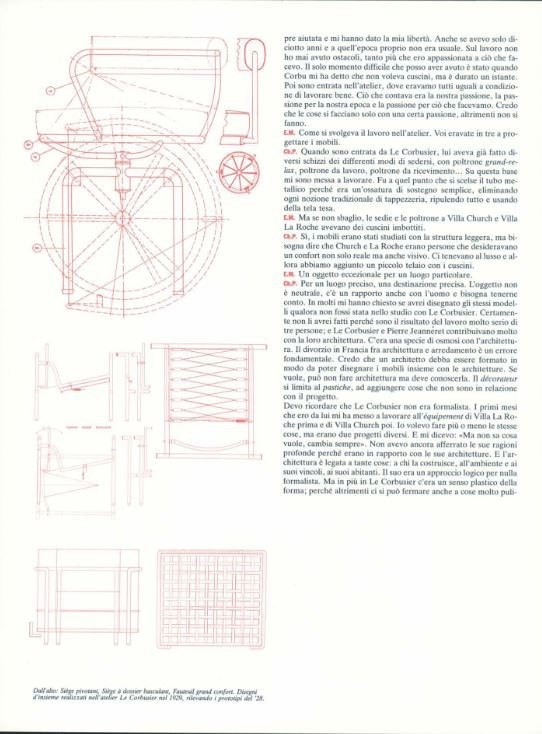
Besides your work in Le Corbusier’satelier, you also were an active member of the UAM (Union des Artistes Modernes).
At the 1928 Salon I got the idea of setting up a small group of young people so that its work would express the new machine aesthetic. René Herbst made his metal chairs, I remember; other members were Djo Bourgeois, Salomon (who designed light), Fouquet the jeweller, and Jean Puiforcat. This group was a big success. So we invited other artists to join - Francis Jourdan and Pierre Chareau, for example. The idea was to hold a joint exhibit at the Salon des Artistes Décorateurs. But they refused to give us space: they said it was impossible to hold a show within the show. So we all withdrew and founded the Union des Artistes Modernes.
Our purpose was to assert the unity of all the “multidisciplines” concerned with man and living: town planning, architecture, gardens, household equipment, furniture, jewellery, goldsmithery, tables, fabrics, everything. There was just one condition: willingness to express our era using the new materials which had become available. Moreover, it had to follow the ethics of our times - an ethics of technological and mechanical functionality. This led to Fouquet’s jewellery which consisted of tiny machines. It also resulted in a certain type of purism which made us select things we thought were good, like Nicolas’ wine-tasting glasses (this was a famous wineshop chain). It was a multidiscipline but it was part of an antidecorative trend. We didn’t work together. But the lovely thing, something which no longer exists today, was linking all the disciplines with the idea that, through our work, we coulddevel op our ideas in every field.
Did you or other artists in the group have the opportunity of working with manufacturers?
Herbst worked in the Technical Departmentof the Otua(Office Technique pour l’Utilisation de l’Acier). We collaborated with Thonet. One mustn’t forget that that era was against making those chairs. They were treated as hospital or bistrots furniture and these limited applications didn’t interest furniture makers. Another thing we need to remember is that the Otua didn’t sell to the public. Decorating was controlled by shops and they were interested in period pieces and upholstery; they certainly weren’t interested in our research which might have led to mass-production. But if we really had reached mass-production we probably would have made different models. The reason is that there would have been some economic problems and some special technical procedures too. We had our furniture made by craftsmen, not by factories; a plant would have used different methods, so the result would have been different.
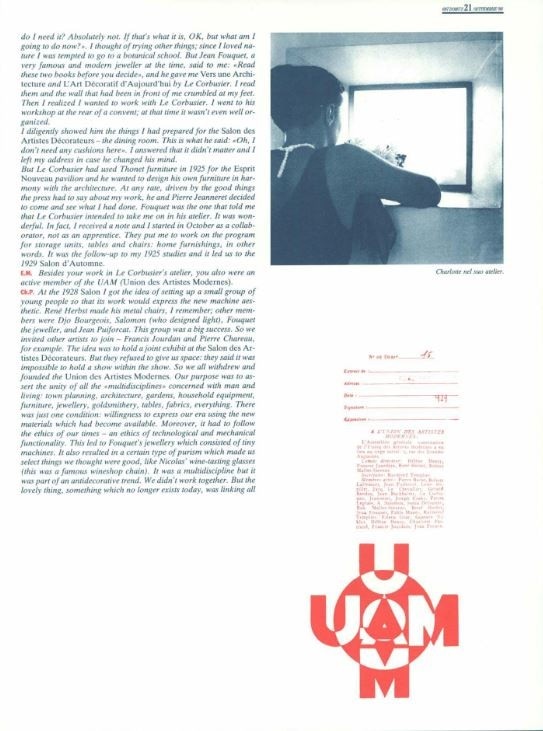
Not many women worked like you did during that period; perhaps the only one was Eileen Gray. Did the fact that you were a girl ever create any problems for you?
Not at all. My parents always helped me as much as they could and they gave me my liberty, even if I was only eighteen. It was quite unusual at that time. In my work I never ran into any obstacles, especially because I loved what I was doing. The only moment which you might call difficult occurred when Corbu told me he didn’t want cushions. But it only lasted a second. Then I joined the workshop where we were all equals provided that we did good work. What counted was our enthusiasm for our era and for what we were doing. I believe that you need enthusiasm to do things.
How was your work in the atelier organized? There were two other people besides you designing furniture.
When I started working in Le Corbusier’s atelier he already had made several sketches of diverse ways of sitting: grand-relax armchairs, work chairs, reception chairs, etc. I started off from there. That’s when we decided to use tubing because it was a simple support element; every traditional idea of upholstery was eliminated, everything was cleaned up and stretched fabric was used.
If I’m not mistaken, the chairs and armchairs at Villa Church and Villa La Roche had upholstered cushions.
Yes, the furniture was designed with a lightweight frame, but Church and La Roche wanted visual, not just real, comfort. Luxury was important for them so we added a small frame with cushions.
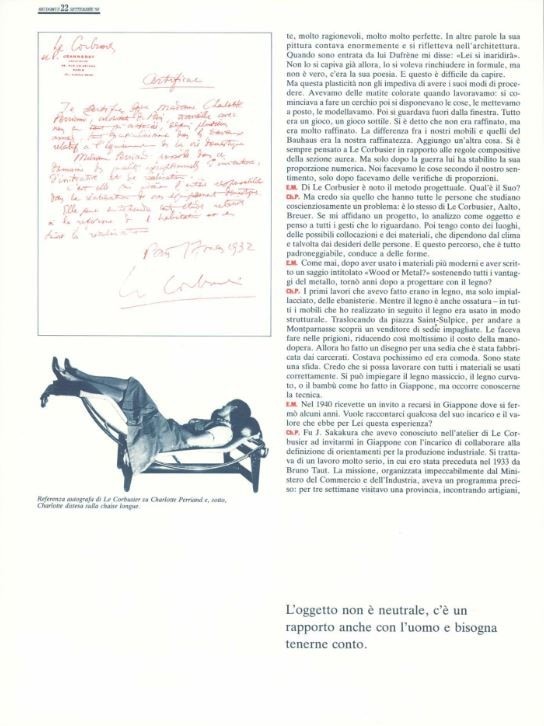
An exceptional object for a special place.
For a precise place, a precise destination. The object isn’t neutral, it has a relationship with man and this had to be taken into account. Many people have asked me if I would have designed the same models if I hadn’t been in Le Corbusier’s workshop. Of course I wouldn’t have; they are the result of very serious work by three people. And Le Corbusier and Pierre Jeanneret contributed a lot with their architecture. There existed a kind of osmosis with architecture. The divorce in France between architecture and furnishings is a serious mistake. I believe that an architect has to be trained so he can design the furniture together with the architecture. He doesn’t have to do architecture if he doesn’t want to, but he has to know it. Décorateurs never go beyond pastiche and adding things that have nothing to do with the project.
I’d like to remind you that Le Corbusier wasn’t a formalist. During my first few months in his atelier he had me work on the équipement for Villa La Roche first, and then for Villa Church. I wanted to do more or less the same things for both homes, but they were different projects. I used to say to myself: “What does he want, he’s always making changes”. “I hadn’t grasped his deep-seated reasons yet: they were related to his buildings. And architecture is linked to many things: to who builds it, to the environment and its constraints, to its inhabitants. Le Corbusier’s approach was logical; there was nothing formalist about it.
What’s more. Le Corbusier had a plastic sense of form. Otherwise, one can just do some very clean, very rational and very very perfect things. In other words, his painting was enormously important and it influenced his architecture. When I went to work for him Dufrène said to me: “You will become arid”. Le Corbusier was misunderstood even then, they tried to wrap him up in formulas: but it’s not true, his art was there. And this is difficult to grasp. But this plasticity didn’t prevent him from having his procedures. We had colored pencils when we worked: we started by drawing a circle then we displayed the things, we arranged them, we shaped them. Then we looked out of the window for a while. It was all a game, a subtle game. Some people said that all this wasn’t refined, but it was refined indeed. The difference between our furniture and the Bauhaus’ lay in our refinement. I’ll add one more thing. When thinking of Le Corbusier’s compositional rules the golden section always comes to mind. But he didn’t establish its numerical proportions until after the war. We did things in accordance with our feelings; we checked the proportions afterwards.
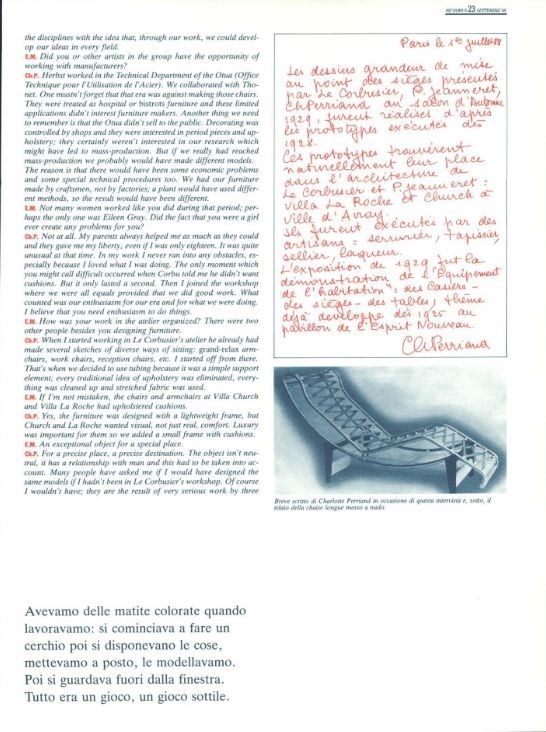
We know about Le Corbusier’sdesign method. What about yours?
I think it’s the same one that everybody who studies a problem conscientiously has: it’s the same as Le Corbusier’s,Aalto’s, Breuer’s. If they commission me to do a project, I analyze this object and think of all the possible gestures which concern it. Then I take into account the place, the possible arrangements and the materials; they depend on the climate and sometimes on personal preference. And this procedure, which can all be mastered, leads to forms.
You used the most modern materials and you wrote an essay called “Wood or Metal?”, stressing all the advantages of metal. How come you went back to designing with wood years later?
My early work was in wood, but it was only veneered; it was cabinetmaking. Wood can also be used for the frame and in all the furniture I designed later wood was used structurally. When I was moving from Place Saint-Suplice to Montparnasse I discovered a man who sold straw-bottomed chairs. He had them made in prisons, drastically cutting the cost of labor. So I designed a chair which was made by prisoners. It was very inexpensive and it was comfortable. They were a challenge. I think you can use all kinds of materials if you use them properly. You can use solid wood, bent wood, or bamboo, like I did in Japan, but you have to learn the technique.
In 1940 you were invited to go to Japan where you stayed several years. Can you tell us something about what your job was and what value this experience had for you?
J. Sakakura, whom I had met at Le Corbusier’s atelier, asked me to come to Japan to help define industrial production policy. This was a very serious job; my predecessor in 1933 had been Bruno Taut. The mission was flawlessly organized by the Ministry for Trade and Industry and it had a precise program. For three weeks I visited one of the provinces meeting craftsmen and students in the schools and the prefectures. Then I spent eight days in Tokyo, staying at Frank Lloyd Wright’s Imperial Hotel.
Unlike the present, the Japan I was lucky to know was very traditional, before the change. I just loved Japanese homes, so modern and simple. All the dimensions, including the window height, are based on the talami module. The Imperial Palace and a peasant’s home have the same module. You don’t need an architect to build. The structures are very light, with simple bamboo bracing. All the interior walls slide on coulisse inserted in the structure. They consist of paper panels; newspaper is used to fill them up, then finishing sheets are added. Everything is so light that even a child can move the walls. Our walls weigh tons. At that time buying tatamis or windows was as easy as going to the baker’s. Industrialization had already arrived there. Today we have some light materials which are a NASA spin-off; they are very thin and good insulators from heat, cold and noise. I’m sure that if we did research in the right direction something would come up.
The facades of their homes were modular and sliding; the panels were completely removable. This is part of their philosophy, based on symmetry and the ephemeral. It is the religion of the void, of Zen space which can contain everything. Later they became Westernized.
Their traditional home construction art, exemplified by their splendid peasant houses and their palaces, was extremely standardized. But these buildings still were hightly flexible. This spirit has been lost. I have to admit that the best Japanese architects haven’t had a chance yet to come to grips with this new problem of the modern home. The traditional individual homes have been replaced by factory-made products, by robotized dwellings. Man no longer is directly involved in designing his own home. He lost that spontaneous link - standard modules made by artisans throughout the country - which enabled him to conceive his dwelling. It is a precious portion of the Japanese’s cultural heritage that is disappearing unanalyzed. And no standard imposed by authorities has been able to bring it back.


